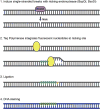New technologies to uncover the molecular basis of disorders of sex development
- PMID: 29655603
- PMCID: PMC7249677
- DOI: 10.1016/j.mce.2018.04.003
New technologies to uncover the molecular basis of disorders of sex development
Abstract
The elegant developmental biology experiments conducted in the 1940s by French physiologist Alfred Jost demonstrated that the sexual phenotype of a mammalian embryo depended whether the embryonic gonad develops into a testis or not. In humans, anomalies in the processes that regulate development of chromosomal, gonadal or anatomic sex result in a spectrum of conditions termed Disorders/Differences of Sex Development (DSD). Each of these conditions is rare, and understanding of their genetic etiology is still incomplete. Historically, DSD diagnoses have been difficult to establish due to the lack of standardization of anatomical and endocrine phenotyping procedures as well as genetic testing. Yet, a definitive diagnosis is critical for optimal management of the medical and psychosocial challenges associated with DSD conditions. The advent in the clinical realm of next-generation sequencing methods, with constantly decreasing price and turnaround time, has revolutionized the diagnostic process. Here we review the successes and limitations of the genetic methods currently available for DSD diagnosis, including Sanger sequencing, karyotyping, exome sequencing and chromosomal microarrays. While exome sequencing provides higher diagnostic rates, many patients still remain undiagnosed. Newer approaches, such as whole-genome sequencing and whole-genome mapping, along with gene expression studies, have the potential to identify novel DSD-causing genes and significantly increase total diagnostic yield, hopefully shortening the patient's journey to an accurate diagnosis and enhancing health-related quality-of-life outcomes for patients and families.
Keywords: DSD; Exome; Genome mapping; Testis development; Whole genome sequencing.
Copyright © 2018 Elsevier B.V. All rights reserved.
Figures



References
-
- Koopman P, Sinclair A, Lovell-Badge R. Of sex and determination: marking 25 years of Randy, the sex-reversed mouse. Development. 2016;143(10):1633–1637. - PubMed
-
- Ono M, V, Harley R. Disorders of sex development: new genes, new concepts. Nat Rev Endocrinol. 2013;9(2):79–91. - PubMed
-
- Li Y, Zheng M, Lau YF. The sex-determining factors SRY and SOX9 regulate similar target genes and promote testis cord formation during testicular differentiation. Cell Rep. 2014;8(3):723–733. - PubMed
-
- Sekido R, Lovell-Badge R. Sex determination involves synergistic action of SRY and SF1 on a specific Sox9 enhancer. Nature. 2008;453(7197):930–934. - PubMed
Publication types
MeSH terms
Grants and funding
LinkOut - more resources
Full Text Sources
Other Literature Sources

